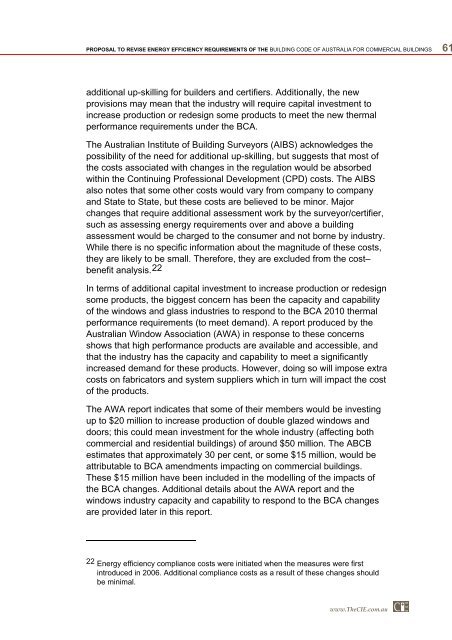PDF | 2 MB - Australian Building Codes Board
PDF | 2 MB - Australian Building Codes Board
PDF | 2 MB - Australian Building Codes Board
Create successful ePaper yourself
Turn your PDF publications into a flip-book with our unique Google optimized e-Paper software.
PROPOSAL TO REVISE ENERGY EFFICIENCY REQUIREMENTS OF THE BUILDING CODE OF AUSTRALIA FOR COMMERCIAL BUILDINGS 61<br />
additional up-skilling for builders and certifiers. Additionally, the new<br />
provisions may mean that the industry will require capital investment to<br />
increase production or redesign some products to meet the new thermal<br />
performance requirements under the BCA.<br />
The <strong>Australian</strong> Institute of <strong>Building</strong> Surveyors (AIBS) acknowledges the<br />
possibility of the need for additional up-skilling, but suggests that most of<br />
the costs associated with changes in the regulation would be absorbed<br />
within the Continuing Professional Development (CPD) costs. The AIBS<br />
also notes that some other costs would vary from company to company<br />
and State to State, but these costs are believed to be minor. Major<br />
changes that require additional assessment work by the surveyor/certifier,<br />
such as assessing energy requirements over and above a building<br />
assessment would be charged to the consumer and not borne by industry.<br />
While there is no specific information about the magnitude of these costs,<br />
they are likely to be small. Therefore, they are excluded from the cost–<br />
benefit analysis. 22<br />
In terms of additional capital investment to increase production or redesign<br />
some products, the biggest concern has been the capacity and capability<br />
of the windows and glass industries to respond to the BCA 2010 thermal<br />
performance requirements (to meet demand). A report produced by the<br />
<strong>Australian</strong> Window Association (AWA) in response to these concerns<br />
shows that high performance products are available and accessible, and<br />
that the industry has the capacity and capability to meet a significantly<br />
increased demand for these products. However, doing so will impose extra<br />
costs on fabricators and system suppliers which in turn will impact the cost<br />
of the products.<br />
The AWA report indicates that some of their members would be investing<br />
up to $20 million to increase production of double glazed windows and<br />
doors; this could mean investment for the whole industry (affecting both<br />
commercial and residential buildings) of around $50 million. The ABCB<br />
estimates that approximately 30 per cent, or some $15 million, would be<br />
attributable to BCA amendments impacting on commercial buildings.<br />
These $15 million have been included in the modelling of the impacts of<br />
the BCA changes. Additional details about the AWA report and the<br />
windows industry capacity and capability to respond to the BCA changes<br />
are provided later in this report.<br />
22 Energy efficiency compliance costs were initiated when the measures were first<br />
introduced in 2006. Additional compliance costs as a result of these changes should<br />
be minimal.<br />
www.TheCIE.com.au
















